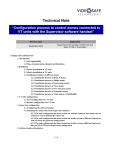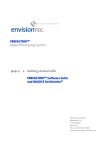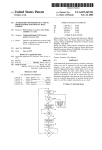Download Video/Display Problems - Service & Support
Transcript
Chapter 8: TROUBLESHOOTING 8 Everyone has problems on occasion. Fortunately, most problems have occurred before and we have answers for them. Below are some of the most common confusions and issues you may run into when running RealPlayer. If you still have unanswered questions, please visit http://service.real.com for the most up-to-date information. (See also Help with Using RealPlayer on page 7.) Video/Display Problems How do I get Full Screen to work? For Windows If you are having problems with Full Screen (e.g., only a black screen appears), make sure that you have the following installed on your machine: Microsoft DirectX with DirectDraw (v5.0 or later) You can access the most recent version and installation instructions from RealNetworks DirectDraw Support page: http://service.real.com/fullscreen/ When you install DirectX, you must choose to upgrade your video drivers. Updated video drivers You can usually find the latest drivers on the website of the company that manufactured your video card. By upgrading your video drivers you may lose some functionality provided by your old drivers. Your video card manufacturer is solely responsible for the scope of these functions. As a convenience we offer links to some of the most common video card manufacturers on the RealNetworks' video driver support page: http://service.real.com/fullscreen/driverlink.html 75 CHAPTER 8: Troubleshooting RealPlayer 8 Plus User Manual For Macintosh If Full Screen does not seem to be working, try selecting Full Screen from the Zoom control after you have connected to the clip you wish to view. How do I exit Full Screen mode? Use the ESC key (Escape key) on your keyboard to exit Full Screen mode in Windows or press any key to exit Full Screen on a Macintosh. Why is my video playback ugly? RealPlayer attempts to show video at whatever color depth your system is set to display. If the color settings in your Control Panel are set less than 16-bit, (see System Requirements on page 3) you will get poor or no results when viewing video clips. You should increase your screen resolution to 16-bit (thousands) or 24-bit (millions) color. To change your color depth in Windows 1. Choose Settings/Control Panel from your Start button. 2. Double-click Display. 3. Click the Settings tab. 4. Change the Color palette setting to High Color (16-bit) or True Color (24bit). Warning You may not be able to go to a higher color setting depending on the desktop area you have selected and your video card. Windows will only allow you to select choices that are appropriate for the installed video driver. 5. Click Apply. You may have to reboot your computer to have the changes take effect; Windows will inform you if you do. Additional Information Avoid using Zoom (see Display panel on page 14) if you do not have a high bandwidth connection or very good connection. 76 RealPlayer 8 Plus User Manual CHAPTER 8: Troubleshooting To change your color depth on Macintosh 1. From the Apple Menu, select Control Panels. 2. Open the Monitors & Sound control panel. 3. Change Color Depth to Thousands or Millions. 4. Change Resolution to 800x600 or better. Why is my video distorted or not displaying at all [Windows]? To deliver the best video in the fastest way possible, RealPlayer uses the latest optimized video protocols. Not all video cards or their drivers will function properly with this optimized approach. If a video card or its drivers are incompatible you may see unexpected results (see The Symptoms immediately below). The Symptoms Incompatibility with optimized video usually manifests itself in one of the following ways: 1. You do not see any video in your RealPlayer Display panel. All you see is an empty, magenta square. 2. You do not see any video in your RealPlayer, only a snowy picture that moves. (Go to Turn off Optimized Video on page 78.) 3. You see video in your RealPlayer but it has a green tint to it and may be distorted so that you only see stripes of the video or only part of an enlarged picture. The overall effect is as if you were looking through a hole at a larger screen. 4. You see video in your RealPlayer but it is stretched vertically or horizontally in only one direction. The picture distorts into a wide, flat picture or a tall, thin one. 5. You see video, but it is more like a slide show than moving pictures and/or the edges are ragged and pixelated (looks like it is made up of a bunch of blocks rather than a clear picture). If you are experiencing one, or more, of these symptoms, confirm the problem by using the test below to be sure that optimized video is the issue and not some other conflict. 77 CHAPTER 8: Troubleshooting RealPlayer 8 Plus User Manual Confirming the Problem If you are seeing any or all of the above symptoms, do the following to make sure it is an optimized video issue: 1. Connect to a video clip or click Play to start playing a loaded video clip. 2. Wait until the video is exhibiting one of the above symptoms. 3. Click and hold on the title bar of your RealPlayer (the blue bar on the top of the Player). 4. Drag your RealPlayer to a new location on your desktop. If you saw the video playing properly while you were dragging your RealPlayer but the problems reappeared when you stopped dragging your RealPlayer (or shortly after you stopped dragging it): Turn off Optimized Video 1. Select View/Preferences... from your menus. 2. Go to the Performance tab (see Performance Preferences on page 71). 3. Find Video card compatibility at the bottom of the tab. 4. Deselect (uncheck) Use optimized video display. 5. Click OK. 6. Close RealPlayer and restart it. (If you have StartCenter running, you will need to close this as well to fully restart RealPlayer. To close StartCenter, right-click on the StartCenter icon and select Close StartCenter. StartCenter will restart when you launch your Player again). 7. Attempt to play the video again. If you still do not see the video playing properly, then other issues may be affecting your RealPlayer. Contact Technical Support at http://service.real.com for access to the RealPlayer Frequently Asked Questions (FAQ) and other up-to-date and technical information. If you update or change your video driver or video card, you should reselect Use optimized video display to see if it works properly. If it does not, follow the instructions above again to solve the conflict. 78 RealPlayer 8 Plus User Manual CHAPTER 8: Troubleshooting Why is my video showing in my menus [Macintosh]? If video appears in your menus while you are using RealPlayer, for instance when you open a module or drop-down menu over RealPlayer and rather than seeing the menu, you see video in the square, there are two solutions. 1. Move RealPlayer more toward the center of your screen or away from any menus. 2. Turn off Optimized video (described below). Turning off optimized video will slow the performance of RealPlayer. a. Select View/Preferences... from your menus. b. Go to the Performance tab (see Performance Preferences on page 71). c. Find Video card compatibility at the bottom of the tab. d. Uncheck Use optimized video display. e. Click OK. f. Close any current clips. g. Attempt to play the video again. Audio Problems Why is my audio playback poor? Playback quality varies depending on available bandwidth and how the file you are playing was encoded. If the quality is garbled, choppy, or skipping, use the following guidelines to isolate and correct the problem. If the quality was poor when firstrun_plus.smi or Welcome.smi file played at the end of the RealPlayer installation, you could have a sound card conflict. Try changing the settings on the Performance tab (see Performance Preferences on page 71). If the quality was good when the firstrun_plus.smi or Welcome.smi file played at the end of the RealPlayer installation, but is bad when you try to play a clip from a web, use the View/Statistics to check for lost packets (see your RealPlayer Help file for more information on the Statistics pane). If the packet loss is high, it may be due to a busy network. If this is the case you should also see the net health indicator blinking yellow or red on your Status bar. RealPlayer users can select PerfectPlay Mode from the Play menu and try to play the clip again or connect to the site at a later time. 79 CHAPTER 8: Troubleshooting RealPlayer 8 Plus User Manual If the quality was good when the firstrun_plus.smi or Welcome.smi file played at the end of the RealPlayer installation, but sounds bad for every clip that you try to play on the Internet, complete the following steps. If the playback quality is poor on every site: 1. Check the actual modem connection speed. This speed may be shown in the lighted display for external modems or through an information window if you have an internal modem (check the user manual for your modem). Sometimes service providers use a lower rate connection speed such as 28.8Kbps, so, even though you are dialing in to your ISP on a 56Kbps modem, you are only receiving data at 28.8Kbps. 2. If your computer seems sluggish during playback, try adjusting your playback performance. On the Performance tab of your Preferences, adjust the Playback Performance slider closer to Lowest CPU usage. 3. If audio on every site is scratchy, popping, or distorted, click Settings... in the Sound card compatibility section of the Performance tab and choose Disable 16-bit audio . (Windows only) 4. If you are getting no audio or audio is playing back quickly (everything sounds like a chipmunk), click Settings... in the Sound card compatibility section of the Performance tab and choose Disable custom sampling rate . 5. If you are using an external modem with a Windows PC and the Statistics window shows minimal packet loss (10% or less), your system may have a problem with the speed at which packets are transferred between the modem and your computer. Try setting the port speed higher (at least twice the modem speed). 6. Contact RealNetworks' Technical Support at http://service.real.com Why doesn't my RealPlayer have a Volume Control? In Compact Mode the Volume Slider changes to a pop-up control. Click to pop-up the volume slider. When you click off of the slider, it will disappear again, but your setting will remain active. The Mute button is available next to the volume control once you open it as described above. 80 RealPlayer 8 Plus User Manual CHAPTER 8: Troubleshooting Why cant I hear anything? RealPlayer uses the Wave interface for Windows to get the sound out to your speaker. In some cases this may have been accidentally turned off by other programs or users. The Wave interface Volume Control In the Windows system tray (the area that shows you the date and time opposite the Start button) you may see a Volume Control (a small icon that looks like a speaker). Double-click on the icon to open the control applet. Make sure that the Wave slider is not muted and is set above zero and that the Master Control is turned On. Connection Problems Why can't I play clips on my computer at work? If you're on a local area network which is attached to the Internet, and are unable to play RealMedia files from remote web sites, it's possible that your company's firewall is preventing the stream from reaching you. Users can receive live and on-demand audio and video from the Internet without exposing their company's network to security risks. If your computer is behind a firewall, please see RealNetworks' firewall page for more information: http://service.real.com/firewall/ Why does RealPlayer use the wrong ISP? When attempting to connect automatically to the Internet, RealPlayer will select your default Internet connection. If you have more than one Internet Service Provider (ISP), RealPlayer may be selecting the wrong one. To change your default ISP in Windows95 1. Choose Settings/Control Panel from your Start button. 2. Double-click Internet. 3. Click the Connection tab. (Some browsers have this on the Settings tab.) 4. Change the Dial-up Connection setting to your preferred ISP. 5. Click Apply. 81 CHAPTER 8: Troubleshooting RealPlayer 8 Plus User Manual Note Windows98; re-run the Internet Connection Wizard. To change your default ISP on Macintosh 1. Open the Remote Access control panel from the Apple Menu. 2. Select Configurations. 3. Choose the appropriate ISP. 4. Click Make Active. 5. Click Done. 6. Open the TCP/IP control panel from the Apple Menu. 7. Enter the appropriate information for the ISP. 8. Click Done. Am I behind a Firewall? Do I need to use Proxy? If you are behind a firewall you may consistently have one of the following problems: You are accessing the Internet via an Internet Service Provider or a cable modem and have trouble connecting to RealAudio or RealVideo files on some or all Web sites but you can play local .RM or .RA files such as videotest.rm, which was copied to your RealPlayer directory when RealPlayer was installed (c:\Program Files\Real\RealPlayer by default, Windows only). 1. You are on a local area network which is attached to the Internet, and are unable to play RealAudio and RealVideo files from some or all remote Web sites but you can play local .RM or .RA files such as videotest.rm, which was copied to your RealPlayer directory when RealPlayer was installed (c:\Program Files\Real\RealPlayer by default). 2. You receive one of the following errors consistently while trying to play content: Error 18: Invalid socket error Error 22: Requested server is not valid Error 108: Invalid Auto Transport Configuration Setup If you are still unsure about whether or not you are behind a firewall, contact the Systems Administrator for your ISP or your company. First attempt to Auto-configure your transport settings: 82 RealPlayer 8 Plus User Manual CHAPTER 8: Troubleshooting 1. From the File Menu, Select View/Preferences. 2. Select the Transport tab. 3. Make sure the dot in front of Automatically Select Most Efficient Transport is selected. 4. Click Auto-Configure... 5. The Auto Transport Configuration box should come up. 6. Click OK. 7. As soon as the configuration is done, the message, Auto Transport Configuration is complete will appear in the box. 8. Click OK. Attempt to play a clip on the Internet. If this does not help, you may try to manually configure the Player for the firewall. The RealPlayer can be configured to receive RealAudio/RealVideo through several different transport methods in order to accommodate firewalls. These transport methods include: UDP on a single port TCP-only HTTP-only The UDP option may offer better sound quality than TCP, so TCP-only may not be desirable. The RealPlayer also offers the ability to limit those inside a firewall to receiving UDP on only one port, which makes router configuration easier. Please contact your System Administrator for the Port number they have configured for UDP transmission. To configure the RealPlayer to receive UDP through a single port 1. In your RealPlayer, select Preferences on the View menu. 2. Click the Transport tab. 3. Click Use Specific UDP Port and enter the UDP port number through which you want to receive the UDP streams. 4. Click OK to save your changes. To configure the RealPlayer to use only TCP to stream audio or video (no UDP) 1. In your RealPlayer, select Preferences on the View menu. 83 CHAPTER 8: Troubleshooting RealPlayer 8 Plus User Manual 2. Click the Transport tab. 3. Select Use Specified Transports. 4. Click RTSP Settings... and/or PNA Settings... Each transport is set separately. 5. Choose Use TCP to Connect to Server. Make sure that the Attempt to Use TCP for All Content box is the only one checked. 6. When you are finished, click OK. 7. Click OK in the Preferences window to save your changes. To configure the RealPlayer to use receive content through HTTP-only The HTTP-only option allows almost all Players behind a firewall to access RealAudio and RealVideo content. 1. In your RealPlayer, select Preferences from the View menu. 2. Click the Transports tab. 3. Select Use Specified Transports. 4. Click RTSP Settings... and/or PNA Settings... Each transport is set separately. 5. Click Use HTTP Only at the bottom of the dialog. 6. Click OK. 7. Click OK in the Preferences window to save your changes. Additional Information For more information on firewalls, please see the following URL: http://www.real.com/firewall/ In some cases you may need to set a proxy so your RealPlayer can receive information. In most cases, Use my web browsers HTTP proxy (see HTTP Options in Proxy Preferences on page 69) will work. However, depending on the firewall protecting your connection to the Internet this may not be enough. Please contact the System Administrator for the correct address and Port numbers for your network. Incorrect information can cause your RealPlayer to appear to not work. 84 RealPlayer 8 Plus User Manual CHAPTER 8: Troubleshooting Other Problems How can I stop RealPlayer from loading on start-up [Windows only]? When RealPlayer is installed it adds a shortcut icon in your system tray (the area that shows you the date and time opposite the Start button). The icon keeps RealPlayer in idle mode so that it is quickly available should you click on a file that requires RealPlayer and allows your Channel Headlines to automatically update while you maintain a connection to the Internet. Additionally this icon allows you to function on clips that are currently playing even if RealPlayer is minimized. To see these functions, right-click the RealPlayer icon in your system tray. If you wish you remove the icon from your system tray: 1. Right-click the icon. 2. Select Close StartCenter. Closing StartCenter will only disable the feature for the current Windows session. StartCenter will load RealPlayer the next time you reboot Windows. To stop RealPlayer from loading when you start Windows: 1. Select View/Preferences... from your RealPlayer menus. 2. Click the General tab. 3. Click Settings... in the StartCenter section. 4. Uncheck Enable StartCenter. 5. Click Yes to verify that you want to disable StartCenter. 6. Click OK to confirm the changes. What types of files can RealPlayer play? RealPlayer plays a wider variety of media, both locally and over the Internet, than earlier versions. The chart below highlights most of the current file-types that can be played. Plug-ins to play many other file types, such as QT2, MOV, and ASF, are available and new plug-ins are being added all the time to expand RealPlayers abilities for you. If you click on a file that RealPlayer can't currently play, it will attempt to AutoUpdate and install a plug-in to match, or you can check with RealNetworks to see if a plug-in exists. If a plug-in exists, RealPlayer can 85 CHAPTER 8: Troubleshooting RealPlayer 8 Plus User Manual download and install it so you will be able to play the file (see Upgrade Preferences on page 63 and AutoUpdate in your RealPlayer Help). Additional Information In order to make video feasible on the computer, video compression algorithms are used to remove redundant audio and video data. The codec (COmpressor / DECompressor) is the algorithm that does the compression and decompression. Operating Systems come with standard codecs (example, Apple QuickTime or Microsoft Video for Windows) installed. If a file is created with a non-standard codec, the matching codec must be installed on the computer before the file can be played. The codec may be installed as a RealPlayer plugin, or it may be installed directly to the operating system. 86 RealPlayer 8 Plus User Manual CHAPTER 8: Troubleshooting To see which components you currently have installed 1. Select View/Preferences... 2. Click the Upgrade tab. 3. To see the currently installed plug-ins, click Settings... in the RealPlayer Plug-ins section of the tab. You can remove a plug-in by highlighting it and clicking Remove. When first setup, RealPlayer can play the following file types: File Extension: File-type: RM, RA, RAM RealAudio/RealVideo streamed content RealText streamed text formats RealPix streamed PNG, GIF and JPG (j-peg) images Stand alone PNG, JPG and GIF images and animated GIFs MPEG Layer 3 (audio format) RealSystem G2 with Flash RT RP PNG, GIF, JPG MP3 SWF SMIL, SMI WAV, AIFF* MPG, MPEG AVI* ASF* MID, MIDI, RMI SMIL files (see SMIL on page 52) 'Legacy' sound filesolder but prevalent filetypes. (Not fully supported.) Standard MPEG Layer 1 video and Layer 2 audio formats Audio/Video InterleaveMicrosoft video format NetShow files (newer NetShow files may not play correctly) 'MIDI' sound files *When you play this file type with RealPlayer, you may receive an error such as, “Unable to render” or “xxxx decompressor not found” or “Missing codec xxxx.” These errors occure because the file was created with a codec that is not installed on your computer. You need to download and install the necessary codec to play these files. 87













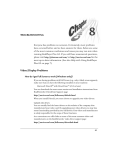

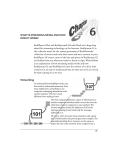
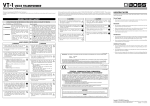
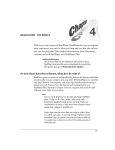
![How to open your Preferences Windows Control Panel [Windows only]](http://vs1.manualzilla.com/store/data/005787188_1-657759d9a2a48c6bde523f6baebed157-150x150.png)
